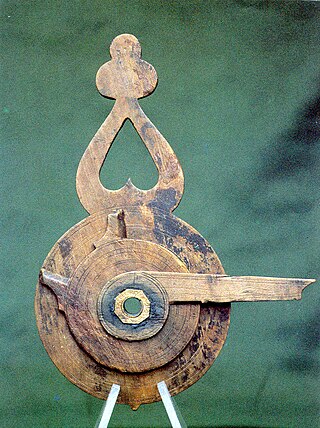
HMS Cornwall was an 80-gun, third rate, ship of the line built for the Royal Navy in the 1690s. She served in the War of the Grand Alliance, and in her first year took part in the Battle of Barfleur and the action at La Hougue.

HMS Culloden was a 74-gun third rate ship of the line of the Royal Navy, launched on 16 June 1783 at Rotherhithe. She took part in some of the most famous battles of the French Revolutionary Wars and the Napoleonic Wars before she was broken up in 1813.

HMS Audacious was a 74-gun third-rate ship of the line of the Royal Navy, launched on 23 July 1785 at Rotherhithe. She was the first ship to bear the name.

HMS Vengeance was a 74-gun third rate ship of the line of the Royal Navy, launched on 25 June 1774 at Rotherhithe. By 1780, she was at the island of Martinique, and was driven ashore and damaged at Saint Lucia in the Great Hurricane of 1780 but recovered and made her way to Portsmouth to be repaired. Finished in 1803, the ship was put into reserve before becoming a prison ship in the year 1808.

HMS Edinburgh was a 74-gun third rate ship of the line of the Royal Navy, launched on 26 November 1811 at Rotherhithe.

HMS Warspite was a 70-gun third-rate ship of the line of the Royal Navy, launched in 1666 at Blackwall Yard. This second Warspite was one of the five ships designed to carry more provisions and lower deck guns higher above the water than French and Dutch equivalents. In 1665 the Second Anglo-Dutch War had begun and on 25 July 1666 Warspite was one of 23 new English warships helping to beat a Dutch fleet off North Foreland, Kent. She won again distinction on Christmas Day 1666 as senior officer's ship out of five sent to protect an important convoy of naval stores from the Baltic. Warspite next took part in the first action of the Third Anglo-Dutch War on 28 May 1672 off Southwold Bay, Suffolk. This desperate 14-hour battle, generally known as Solebay, was a drawn fight; but Warspite successfully fended off a pair of Dutch fire ships exactly as she had done off North Foreland. By 1685, she was mounting only 68 guns.

HMS Edgar was a 72-gun third rate ship of the line of the Royal Navy, built by Baylie of Bristol and launched in 1668. The diarist and naval administrator Samuel Pepys visited the town during its construction, noting that in his opinion, "it will be a fine ship". By 1685 she was carrying 74 guns.
Lyme was a 52-gun third rate Speaker-class frigate built for the navy of the Commonwealth of England at Portsmouth, and launched in 1654.
The Taunton was a 40-gun fourth-rate frigate of the Royal Navy, originally built for the Royal Navy by William Castle at Rotherhithe, and launched in 1654.

HMS Russell was an 80-gun third rate ship of the line of the Royal Navy, launched at Portsmouth Dockyard on 3 June 1692.
HMS Winchester was a 50-gun fourth rate ship of the line of the Royal Navy, one of eight such ships authorised by the Navy Board to be newly built ; the others were the Hampshire, Dartmouth, Salisbury, Worcester, Jersey, Carlisle and Tilbury. The contract for the Winchester was signed with shipbuilders John and Richard Wells in 1696, for the ship to be built in their yard at Greenland North Dockyard, in Rotherhithe, and she was launched there on 17 March 1698.
HMS Dartmouth was a 50-gun fourth rate ship of the line of the English Royal Navy, ordered on 21 June 1692 to be built by commercial contract with the master shipwright John Shish in Rotherhithe, and launched there on 24 July 1693.
HMS Warwick was a 50-gun fourth rate ship of the line of the Royal Navy, one of four ordered in September 1694 to be built by commercial contracts; eight further ships of this type were ordered on 24 December. The Warwick was built by Robert and John Castle at their Deptford shipyard and launched on 20 August 1696.
HMS Leopard was a 50-gun fourth rate ship of the line of the Royal Navy, built at Rotherhithe and launched on 15 March 1703.

HMS St Albans was a 50-gun fourth rate ship of the line of the Royal Navy, built at Rotherhithe and launched on 10 December 1706.

HMS Hampton Court was a 70-gun third-rate ship of the line of the Royal Navy, built at Rotherhithe according to the 1706 Establishment and launched on 19 August 1709.
HMS Gloucester was a 60-gun fourth rate ship of the line of the Royal Navy, built at Rotherhithe according to the 1706 Establishment, and launched on 25 July 1709.

HMS Medway was a 60-gun fourth rate ship of the line of the Royal Navy, built to the 1733 proposals of the 1719 Establishment at Rotherhithe, and launched on 26 May 1742.
HMS Nonsuch was a 50-gun fourth rate ship of the line of the Royal Navy, built to the 1733 proposals of the 1719 Establishment at Rotherhithe, and launched on 29 December 1741.

HMS Maidstone was a 50-gun fourth rate ship of the line of the Royal Navy, built at Rotherhithe to the dimensions laid down in the 1741 proposals of the 1719 Establishment, and launched on 12 October 1744.











